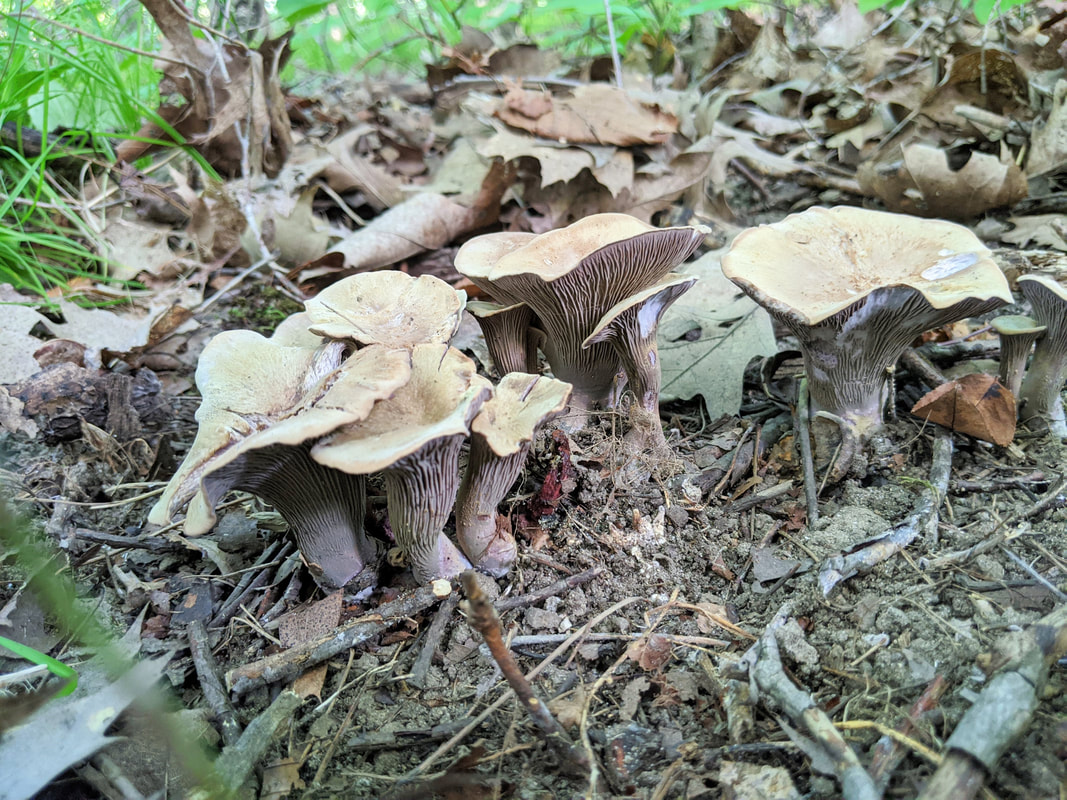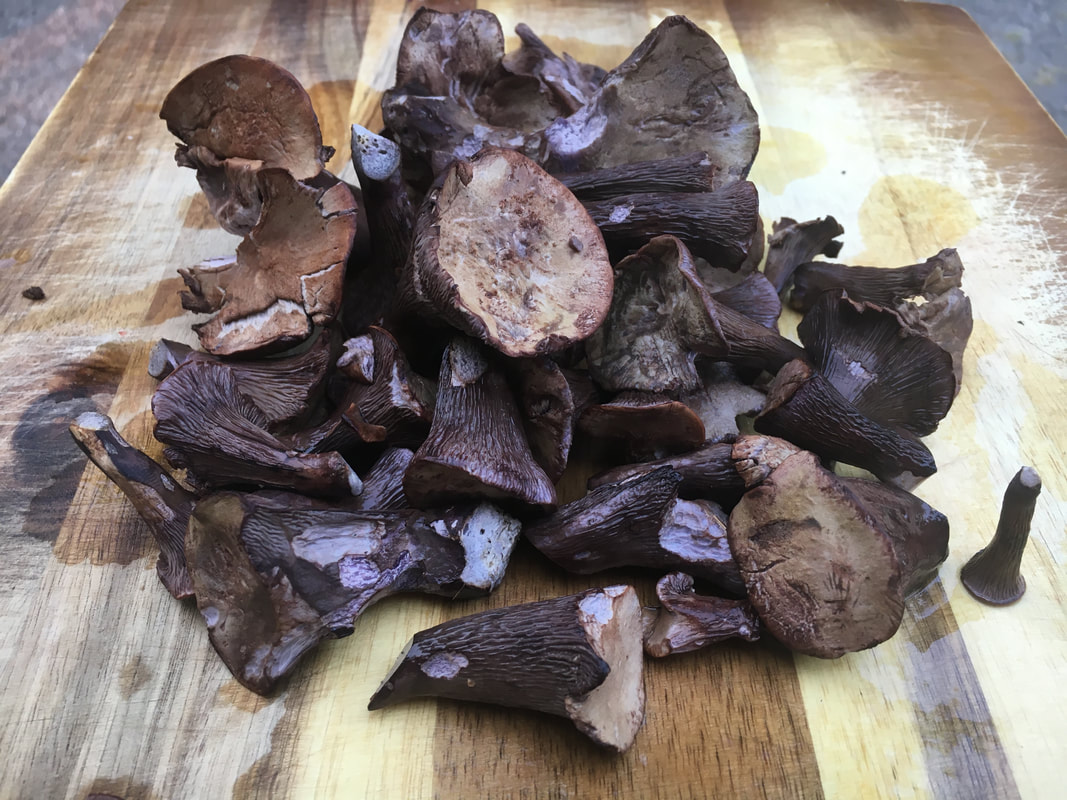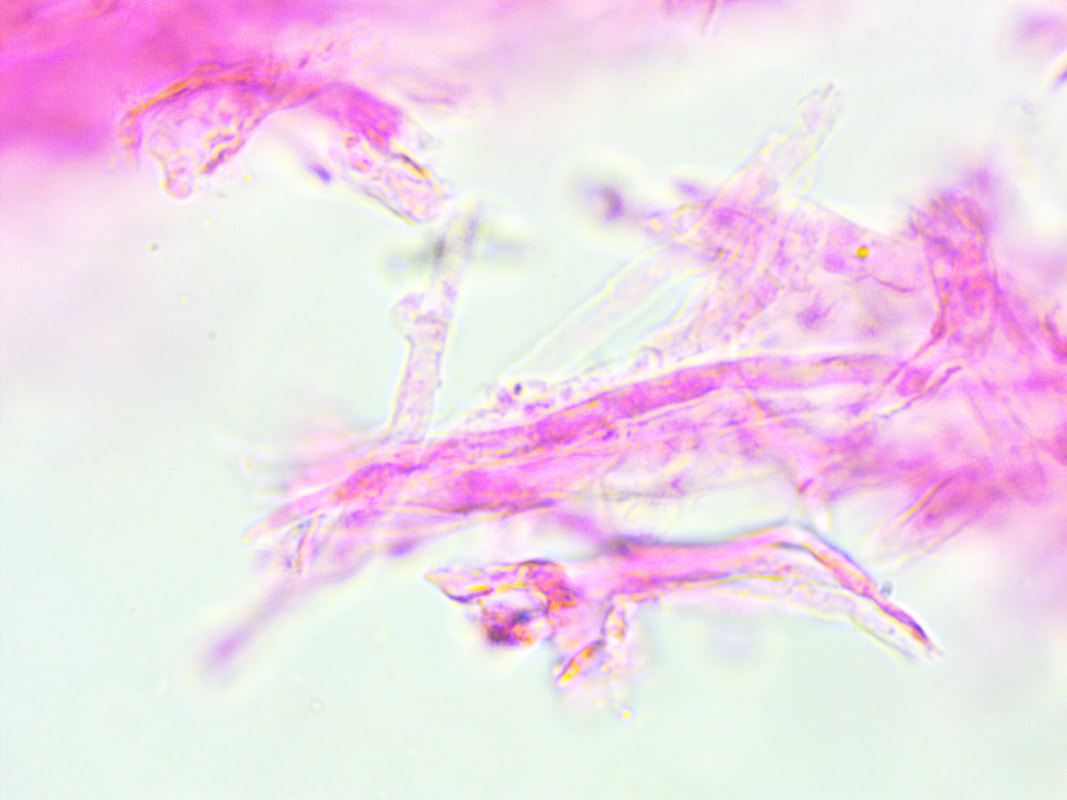|
MycoBank Taxonomy: Fungi, Dikarya, Basidiomycota, Agaricomycotina, Agaricomycetes, Phallomycetidae, Gomphales, Gomphaceae, Gomphus Now and again, a supportive fan of the 1001 Mushroom Project will offer up some of their mushrooms for me to eat and blog about. Because I want to go through the whole process myself (finding, identifying, preparing, and eating a new species), I almost always decline their generous donations, But when a mushroom hunter shared with me photos of these gorgeous lilac "chanterelles", Gomphus ludovicianus, and asked if I'd like them for eating – they'd collected them before but weren't a big fan, or eating any mushroom for that matter – how could I say no? We originally identified these mushrooms as Gomphus clavatus, which never felt like a perfect fit due to inconsistencies in ecology. G. clavatus is reported as predominately associated with conifers (Smith & Morse 1947, Kuo 2021), but these mushrooms were found over multiple years growing with hardwoods. Only after sequencing the ITS ribosomal DNA barcode did the situation clarify. The ITS DNA sequence is identical to the holotype of Gomphus ludovicianus, described from Louisiana and Texas (Petersen et al. 2014). This is essentially the first report of G. ludovicianus outside of the southeast United States, along with Steve Russell's observation in northern Indiana from 2021. Given that Alex Smith was very active collecting and describing cantherelloid and gomphoid mushrooms from Michigan during the middle of the 20th century, it is surprising that he did not document a hardwood-associated Gomphus like this one. Perhaps we are just observing G. ludovicianus now because of an expansion in its range as a result of climate change? Gomphus ludovicianus and G. clavatus look like chanterelles, given their well developed false gills, but are actually in a different taxonomic order, the Gomphales. Pseudocraterellus pseudoclavatus is a nearly identical (but apparently quite rare) lookalike that is a "true" chanterelle, in the order Cantharellales. It's really a stunning case of convergent evolution considering how similar these mushrooms are despite their distant relatedness. The best way to distinguish species from these two orders is under the microscope. Gomphus mushrooms have roughened spores and clamp connections whereas P. pseudoclavatus has smooth spores and hyphae with simple septa (Smith & Morse 1947). When it comes to eating pig ears, fresh mushrooms are key because larvae inhabitants can be a problem. After removing the buggy bits, I chopped the pig ears into chunks, sauteed them, and then tore them into smaller bits. The cooked mushrooms smelled strangely like pancakes and their texture was bizarrely meaty. Inspired by Forager Chef, I decided to make pig ear tacos. My rendition consisted of Japanese mayo, spicy collard greens, pulled pig ears, and scallions. To my surprise, given their distinct appearance, the pig ears tasted mild, maybe a little nutty, but with a bitter finish. For that reason, I rank this mushroom as "good" but not "great" or choice. However, for those of you who enjoy bitter flavor, this might be an all-star mushroom. Besides taste, their texture was fantastic. Pig ears have a real meaty firmness, almost a crunch, that is very satisfying. Gomphus ludovicianus is a unique, bold, and special mushroom whose culinary possibilites I am excited to continue exploring. SpecimenACD0321, 22 August 2020; Lapeer Co., MI, USA; leg. Huafang Su, det. Alden C. Dirks, GenBank OM009270 (ITS rDNA), MICH 352273. ReferencesKuo, M. (2021, August). Gomphus clavatus. Retrieved from the MushroomExpert.Com Web site: http://www.mushroomexpert.com/gomphus_clavatus.html Petersen, R. H., Hughes, K. W., Justice, J., & Lewis, D. P. (2014). A new species of Gomphus from southeastern United States. North American Fungi, 9(9), 1–13. Smith, A. H., & Morse, E. E. (1947). The genus Cantharellus in the western United States. Mycologia, 39(5), 497–534. Retrieved from https://www.jstor.org/stable/3755192 Online Resources
0 Comments
Your comment will be posted after it is approved.
Leave a Reply. |
PermalinksProject Introduction Top EdiblesHericium coralloides
Laetiporus sulphureus Morchella americana Polyporus umbellatus Suillus ampliporus Archives
April 2023
Categories |
|
|
Terms of Use, Liability Waiver, and Licensing
The material on aldendirks.com is presented for general informational and educational purposes only, and under no circumstances is to be considered a substitute for identification of an actual biological specimen by a person qualified to make that judgment. Some fungi are poisonous; please be cautious. All images on this website are licensed under Attribution-NonCommercial-NoDerivatives 4.0 International (CC BY-NC-ND 4.0). |




 RSS Feed
RSS Feed




